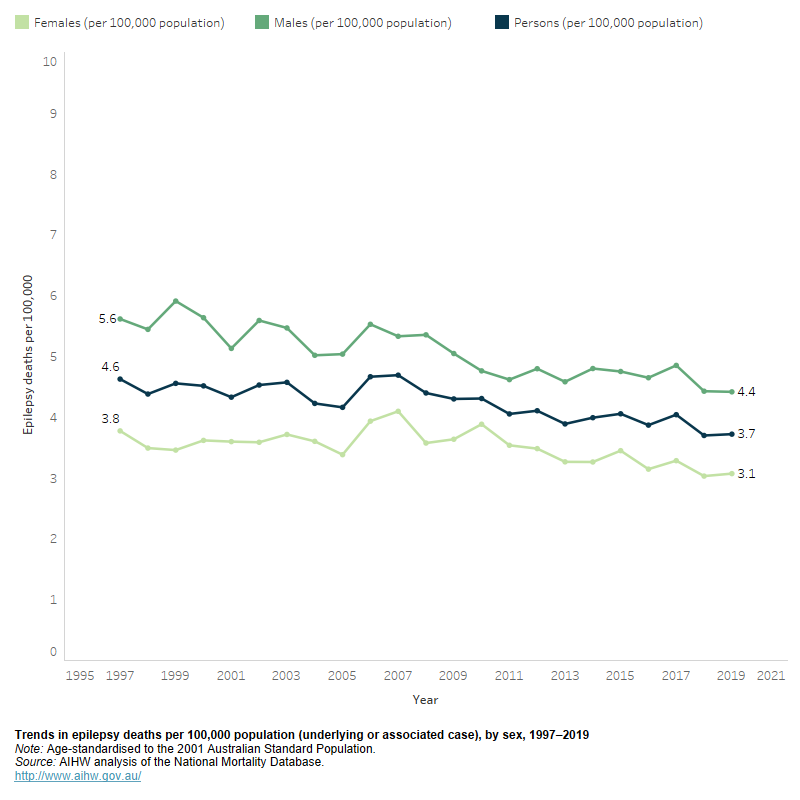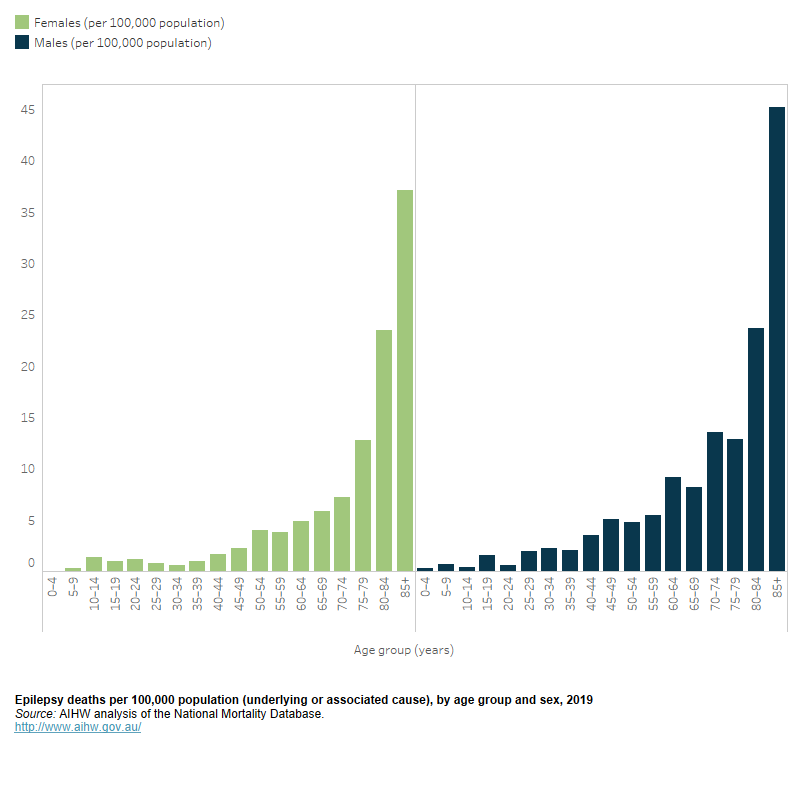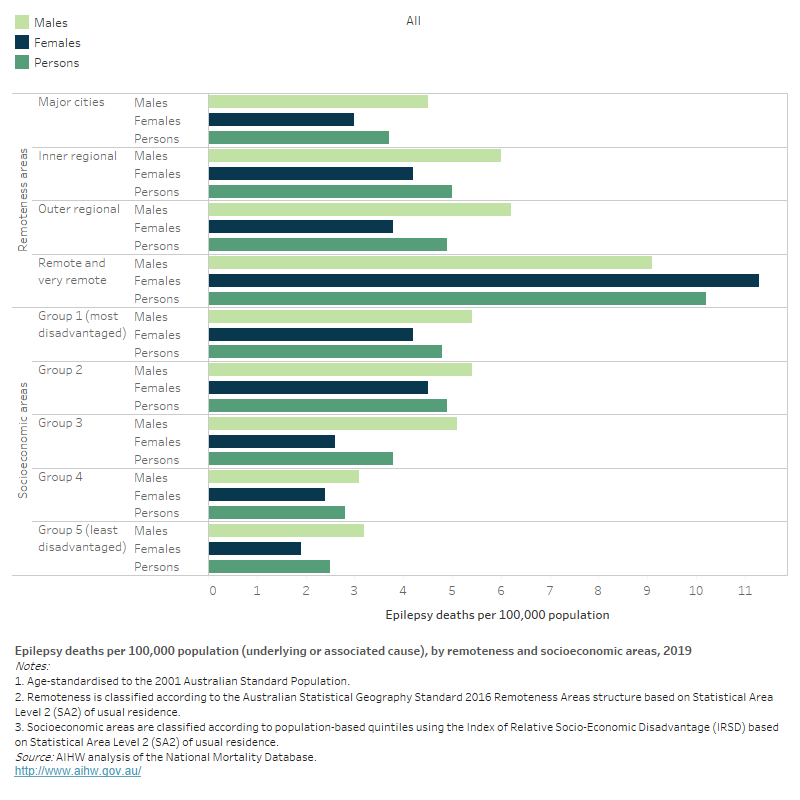Deaths due to epilepsy
Epilepsy contributed to about 1,100 deaths in 2019 (0.7% of all deaths) according to the AIHW National Mortality Database. Epilepsy was the underlying cause of death in around 235 deaths (22% of all epilepsy deaths). It was an associated cause in a further 850 deaths (78% of all epilepsy deaths). While epilepsy as the underlying cause of death is well captured in mortality data, deaths among people with epilepsy (that is, where it is recorded as an associated cause of death) may not be fully captured. All of the epilepsy death statistics below are based on deaths where epilepsy is an underlying or associated cause of death.
Trends
Age-standardised epilepsy death rates have declined over the last 2 to 3 decades (Figure 6.1), both where epilepsy is the underlying cause of death and where it is the underlying or associated cause of death. Between 1997 and 2019:
- Epilepsy death rates decreased from 4.6 deaths per 100,000 to 3.7 per 100,000.
- Males consistently had a higher rate of epilepsy deaths than females (5.6 per 100,000 compared with 3.8 per 100,000 in 1997; 4.4 per 100,000 compared with 3.1 per 100,000 in 2019, respectively) (Figure 6.1).
Figure 6.1: Trends in epilepsy death rates (underlying or associated cause), by sex, 1997–2019
This is a line graph that shows epilepsy deaths per 100,000 population by year on separate lines for males, females and persons. For males, females and persons the death rate has reduced over the period 1997 to 2019. The death rate for males reduced from 5.6 to 4.4, for females from 4.6 to 3.7 and for persons from 3.8 to 3.1 deaths per 100,000 population, where epilepsy was an underlying or associated cause.

Age and sex
In 2019, age-specific epilepsy death rates (underlying or associated cause):
- increased with age from the mid-30s, with rates 1.7 times as high for those in the 85 and over age group (45.2 and 37.1 deaths per 100,000 for males and females, respectively) compared with those in the 75–84 year age group (23.7 and 23.5 deaths per 100,000 for males and females, respectively)
- were generally higher for males than females across the age groups (Figure 6.2).
Figure 6.2: Epilepsy death rates (underlying or associated cause), by age group and sex, 2019
This is a bar chart that displays epilepsy deaths per 100,000 population by age group and sex. It shows epilepsy deaths rates increase with age from the mid-30s and are highest for both males and females in the 85+ age groups.

Variations between population groups
Epilepsy death rates (underlying or associated cause) generally increased with increasing socioeconomic disadvantage and for people residing in Remote and very remote areas (Figure 6.3).
The epilepsy death rates in 2019 were:
- almost twice as high among those living in the lowest socioeconomic areas compared with those living in the highest socioeconomic areas (4.8 and 2.5 deaths per 100,000, respectively). The difference was larger for females than males – 2.2 times as high among people living in the lowest socioeconomic areas as those living in the highest socioeconomic areas for females (4.2 and 1.9 deaths per 100,000, respectively) and 1.7 times as high for males (5.4 and 3.2 deaths per 100,000, respectively)
- 2.8 times as high in Remote and very remote areas compared with Major cities (10.2 and 3.7 deaths per 100,000, respectively). The difference was larger for females than males – 3.8 times as high in Remote and very remote areas than in Major cities for females (11.3 and 3.0 deaths per 100,000, respectively) and twice as high for males (9.1 and 4.5 deaths per 100,000).
Figure 6.3: Epilepsy death rates (underlying or associated cause), by remoteness and socioeconomic area, 2019
This is a horizontal bar chart that displays epilepsy deaths per 100,000 population by remoteness area, socioeconomic area and sex. It shows that death rates were highest in remote and very remote areas and lowest in major cities. It also shows that epilepsy death rates were highest in the most disadvantaged areas and lowest in the least disadvantaged areas.

Aboriginal and Torres Strait Islander people
In 2019, there were 57 deaths of Indigenous Australians where epilepsy was recorded as either the underlying or associated cause. The death rate (underlying or associated cause) was higher for Indigenous males than it was for females (13.1 and 10.5 deaths per 100,000, respectively). Due to data quality issues, these data include people residing in New South Wales, Queensland, Western Australia, South Australia and the Northern Territory only.
After adjusting for differences in the age structure of the populations, the rate of deaths of people with epilepsy was over three times as high among Indigenous Australians as non-Indigenous Australians (12.1 and 3.5 deaths per 100,000, respectively).
The gap in death rates between Indigenous and non-Indigenous Australians was similar for females and males.
References
AIHW (Australian Institute of Health and Welfare) 2016. Australian Burden of Disease Study 2011: methods and supplementary material. Cat. no. BOD 6. Canberra: AIHW.
AIHW 2019. Australian Burden of Disease Study: methods and supplementary material 2015. Cat. no. BOD 23. Canberra: AIHW.
Moran NF, Poole K, Bell G, Solomon J, Kendall S, McCarthy M et al. 2004. Epilepsy in the United Kingdom: seizure frequency and severity, anti-epileptic drug utilization and impact on life in 1652 people with epilepsy. Seizure 13(6):425-33, doi:10.1016/j.seizure.2003.10.002.


